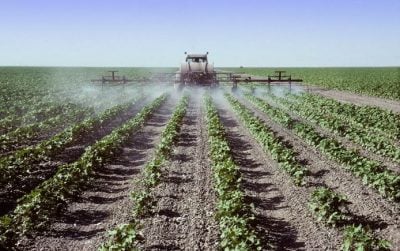Aerially Sprayed Pesticide Contains the PFAS “Forever Chemicals”. Impacts on Human Health
“Forever Chemicals” Potentially Spread Over Millions of Acres

State efforts to control mosquito-borne illnesses may be creating a new health problem. The insecticide Massachusetts and numerous other states use for mosquito control, both applied aerially and sprayed from trucks along roads, contains per-and polyfluoroalkyl substances (PFAS), according to lab test results posted today by Public Employees for Environmental Responsibility (PEER).
Tests commissioned by PEER of a jug of Anvil 10+10, the pesticide used in the aerial spraying programs of Massachusetts, parts of Florida, New York, and many other states, reveals that it contains roughly 250 parts per trillion (ppt) of PFOA (perfluorooctanoic acid, a C8 PFAS, manufacture of which has been largely but not completely phased out in the U.S.), and 260 – 500 ppt of HFPO-DA (hexafluoropropylene oxide dimer acid, a “GenX” replacement for PFOA). When PEER alerted Massachusetts Department of Environmental Protection (MADEP) of its findings, MADEP independently tested nine samples of Anvil 10+10 from five different containers, and found eight different PFAS, including PFOA and PFOS. The U.S. Environmental Protection Agency (EPA) has a 70 ppt Lifetime Health Advisory for PFOA and PFOS in drinking water; some states, including Massachusetts, have much stricter regulatory limits than the EPA Advisory.
PFAS are called “forever chemicals” since they do not break down in the environment and build up in our blood stream. They are associated with a variety of ailments, including suppressed immune function, thyroid disease, testicular and kidney disease, cancers, and liver damage. While PFAS may be added to pesticides as surfactants, dispersants, anti-foaming agents, and/or other uses, it is unclear whether the PFAS found in Anvil 10+10 is an ingredient added by the manufacturer, contained in one of the ingredients supplied to Anvil’s manufacturer by other companies, or whether it is a contaminant from the manufacturing/storage process.
“In Massachusetts, communities are struggling to remove PFAS from their drinking water supplies, while at the same time, we may be showering them with PFAS from the skies and roads,” stated PEER Science Policy Director Kyla Bennett, a scientist and attorney formerly with EPA, who arranged for the testing. “The frightening thing is that we do not know how many insecticides, herbicides, or even disinfectants contain PFAS.” PEER found patents showing chemical companies using PFAS in these products, and recent articles discuss the variety of pesticides that contain PFAS as either an active or an inert ingredient.
In 2019, Massachusetts aerially sprayed 2.2 million acres of the state with this pesticide and, in 2020, sprayed more than 200,000 acres. PFAS are not listed as active ingredients in Anvil 10+10. PEER found PFAS listed as approved inert ingredients on EPA’s “Inert Finder” database. EPA is not required to disclose many inert ingredients in pesticides, and manufacturers usually withhold information about inert ingredients as “trade secrets” or “proprietary” information.
“This PFAS fiasco shows that public trust in EPA having a full accounting of these materials and their safety is utterly misplaced,” added Bennett, whose organization has also been highly critical of EPA’s response to the unfolding PFAS contamination scandals. “Until EPA acts, states need to adopt their own safeguards and chemical disclosure requirements because they certainly cannot depend upon the diligence of EPA.”
*
Note to readers: please click the share buttons above or below. Forward this article to your email lists. Crosspost on your blog site, internet forums. etc.
Featured image is from Pesticide Action Network

